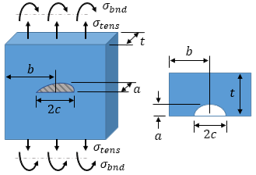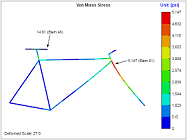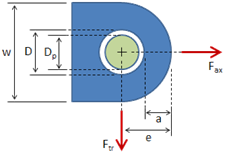Fracture Materials Database
This page allows for the creation of material properties to be used in the Fracture Mechanics and Fatigue Crack Growth calculators on this site. You can create new materials from scratch, or copy from the database.
Your Materials
Display Units:
- Create new materials by clicking the "(new)" row in the table and filling out the text boxes below.
- Edit materials by selecting from the list and updating the text boxes below.
- Import materials from our database on the next tab.
---
Mechanical Properties
Fracture Properties
Fatigue Crack Growth Properties
Flaw Tolerance Curve
Select a material from the table above.
There are not enough properties specified for this material to draw the flaw tolerance curve. The required properties are:
- Yield Strength
- Ultimate Strength
- Elastic Modulus
- Percent Elongation
- K1C
NAVSEA's Fracture Toughness Review Process (FTRP) defines a minimum material that is deemed to be fracture safe. The FTRP also defines a means of calculating a flaw tolerance curve for a material, which is an indication of the material's resistance to fracture. For a material to be considered fracture resistant, it must have a flaw tolerance curve above that of the minimum material curve.
Kc vs. Thickness Curve
Select a material from the table above.
There are not enough properties specified for this material to draw the Kc vs. thickness curve. The required properties are:
- K1C
- Ak
- Bk
The fracture toughness is dependent on part thickness. As the thickness increases the fracture toughness decreases until the plane-strain fracture toughness, K1C.
da/dN Curve
Select a material from the table above.
There are not enough properties specified for this material to draw the da/dN curve. The required properties are:
- K1C
- C0
- n
- p
- q
Below is a plot of crack growth rate, da/dN, versus ΔK for the material used in this analysis. There are several curves shown for varying R-ratios. Note that crack growth rate increases with increasing R-ratio.
Important Note
In this da/dN curve all options that are dependent on geometry have been suppressed.
- Constant K1C -- fracture toughness (critical stress intensity) cannot be a function of part thickness in this case
- Small crack effect ignored
Download da/dN Curve Data to Excel
Download an Excel file to your computer containing data points for the da/dN curve.
Materials Database
Display Units:
- You can copy to your materials by selecting a material from the table and clicking the "Copy" button at the bottom.
Mechanical Properties
Fracture Properties
Fatigue Crack Growth Properties
The calculators on this site can be used for free on a limited basis, but to obtain full use of the calculators you must sign up for an account. By subscribing to MechaniCalc, you will receive the following benefits:
- Unrestricted access to all calculators and other content on this site
- Ability to create new materials and cross sections for use in the calculators
- Ability to save input files so that you never lose your work
- Ability to generate beautifully formatted reports to document results
- Removal of all advertisements and popups
Please visit our pricing page for more details, or visit our sign-up page. You can cancel at any time if you aren't satisfied.
References
The following are valuable sources of fracture and fatigue crack growth data:
- AD-773 673, "Plane Strain Fracture Toughness (KIC) Data Handbook for Metals," Army Materials and Mechanics Research Center, December 1973
- AFRL-VA-WP-TR-2003-3002, "USAF Damage Tolerant Design Handbook: Guidelines for the Analysis and Design of Damage Tolerant Aircraft Structures," November 2002
- DOT/FAA/AR-05/15, "Fatigue Crack Growth Database for Damage Tolerance Analysis," US Department of Transportation, Federal Aviation Administration, August 2005
- MIL-HDBK-5J, "Metallic Materials and Elements for Aerospace Vehicle Structures," Department of Defense Handbook, January 2003
- Sanford, R.J., "Principles of Fracture Mechanics," 1st Edition
Disclaimer
The data in this Fracture Materials Database are believed to be representative of the materials described. However, due to the wide variations possible, the values should not be relied upon to accurately represent the properties of a specific batch of material. Critical design decisions should be based on results taken from the actual lot of material to be used for fabrication, tested under conditions that as accurately as possible mirror service conditions.
The data are provided "as is" without warranty of any kind, either expressed or implied. MechaniCalc, Inc. shall not be liable for any damages arising from the use of these illustrative data.
Refer to our Terms and Conditions for further details.
Feedback
Do you have any comments or suggestions? We would love to hear them!




